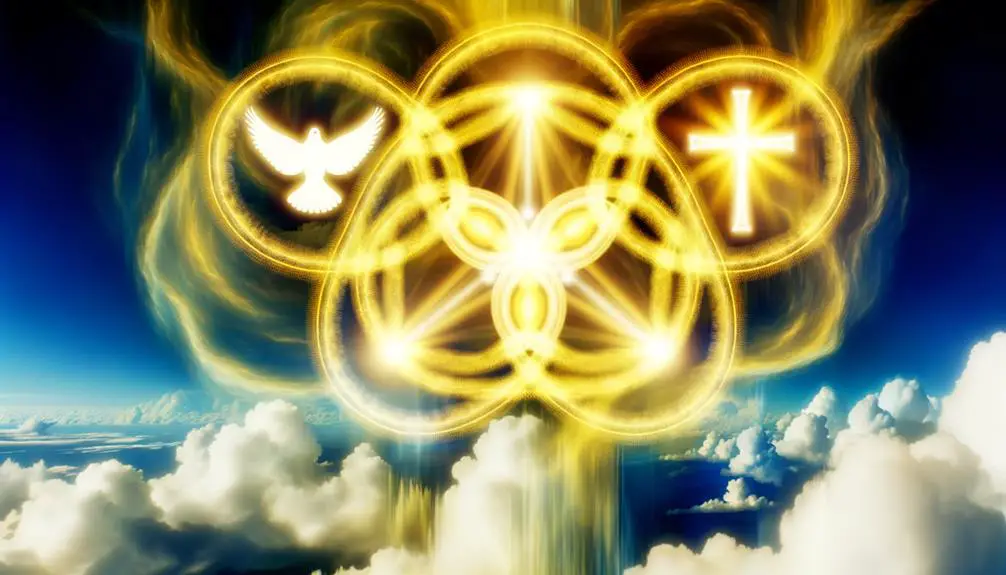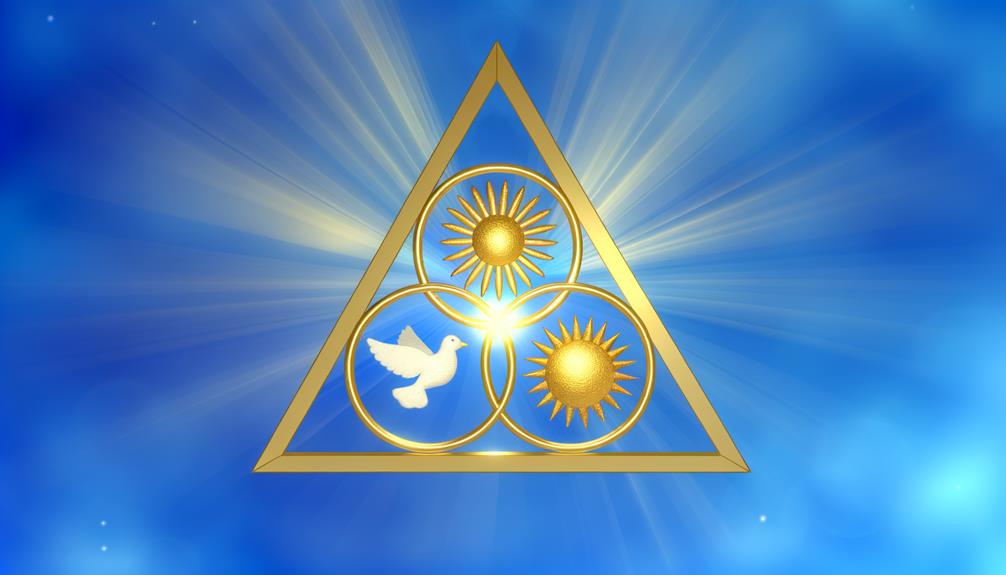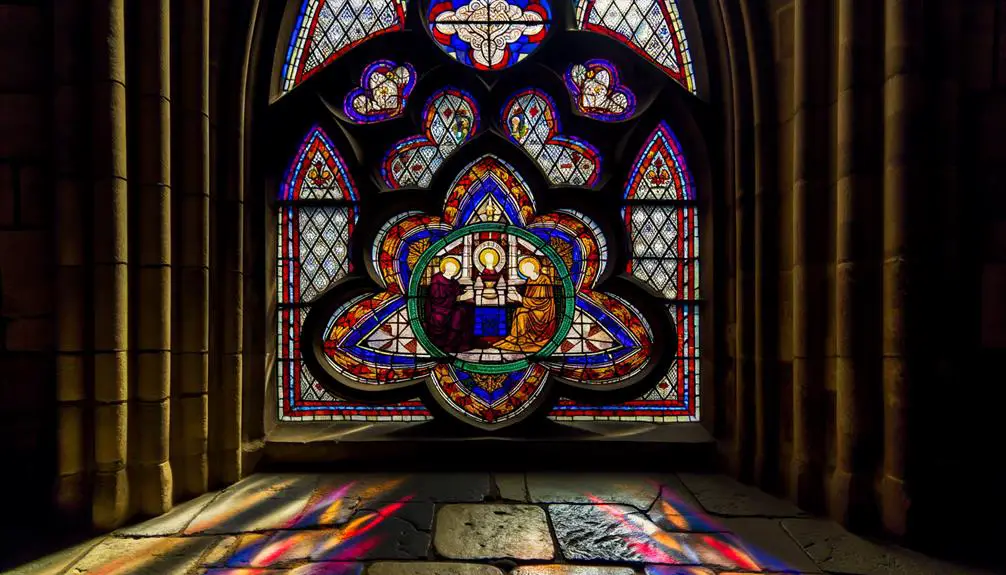What Symbolizes the Holy Trinity?
The Holy Trinity, a cornerstone of Christian theology, is symbolized in various profound ways, signifying the unity of Father, Son, and Holy Spirit. Common symbols include the shamrock, famously used by St.
Patrick to illustrate the divine tri-unity. The equilateral triangle, with its equal sides, represents the co-equality and co-eternity of the three Persons.
Borromean rings illustrate their indivisible unity. These symbols serve as pedagogical tools, fostering understanding of complex theological doctrines.
Each emblem reflects the divine harmony and inter-relation within God, inviting deeper contemplation of this mystical union. Explore further to gain more spiritual and theological insights.

Key Takeaways
- The shamrock, used by St. Patrick, represents the unity and distinctiveness of the Father, Son, and Holy Spirit.
- The equilateral triangle symbolizes divine unity and equality of the three Persons in the Godhead.
- Borromean rings illustrate the indivisible unity and interdependence among the Father, Son, and Holy Spirit.
- These symbols highlight the harmonious relationship and coequality within the Trinity.
- Modern interpretations emphasize the Trinity's relational nature and its deeper spiritual significance.
Historical Origins

The concept of the Holy Trinity, central to Christian theology, has its roots deeply embedded in the early doctrinal formulations of the Church Fathers.
Emerging from the theological discourses of the 2nd and 3rd centuries, the Trinitarian doctrine sought to articulate the co-existence of Father, Son, and Holy Spirit within one divine essence.
Early apologists like Tertullian and Origen contributed significantly to this theological framework, addressing heresies that challenged the unity and distinctiveness of the Godhead.
The Nicene Creed of 325 AD formalized this understanding, asserting the consubstantiality of the Son with the Father.
This development marked a pivotal moment in shaping orthodox Christian belief, underscoring a unified yet tri-personal conception of God that would permeate subsequent theological explorations.
Theological Significance
Understanding the theological significance of the Holy Trinity requires a deep exploration into its implications for Christian metaphysics, soteriology, and ecclesiology.
The Trinity—Father, Son, and Holy Spirit—embodies the unity and diversity within the Godhead, shaping our comprehension of divine nature and relational dynamics. It underpins the doctrine of salvation, revealing how the three Persons work harmoniously for humanity's redemption.
Metaphysics: The Trinity offers a profound insight into God's essence, transcending human understanding while inviting contemplation on divine mystery.
Soteriology: Each Person of the Trinity plays a distinct role in the salvific process, highlighting the cooperative nature of divine grace.
Ecclesiology: The communal aspect of the Trinity serves as a model for the Church, fostering unity and mutual love among believers.
This triune relationship enriches the Christian faith, providing a framework for both theological thought and spiritual practice.
The Shamrock Symbol

The shamrock, famously associated with St. Patrick, served as an ingenious pedagogical tool to elucidate the doctrine of the Holy Trinity.
By pointing to its three leaves united on a single stem, St. Patrick illustrated the unity and distinctiveness within the Godhead—Father, Son, and Holy Spirit.
This botanical analogy underscores the theological concept of three persons in one divine essence, fostering a deeper understanding of the triune nature of God.
St. Patrick's Teaching Tool
St. Patrick famously utilized the shamrock as a pedagogical tool to illustrate the concept of the Holy Trinity to the Irish people. This simple yet profound analogy helped demystify the complex theological doctrine by relating it to a familiar, tangible object.
The shamrock's three leaves symbolized the Father, the Son, and the Holy Spirit, each distinct yet united in one entity.
By using a common plant, St. Patrick made the abstract idea of the Trinity accessible to the uneducated masses.
The shamrock, already significant in Irish culture, provided a relatable and memorable symbol.
The visual nature of the shamrock reinforced the unity and distinctness of the three divine persons, aiding comprehension and retention.
Three Leaves, One Plant
Building on the pedagogical brilliance of St. Patrick's use of the shamrock, the symbol itself eloquently encapsulates the unity and distinctness of the Holy Trinity through its three leaves on a single stem. Each leaf represents one of the Persons of the Trinity—Father, Son, and Holy Spirit—distinct yet inseparable, coexisting in perfect harmony.
This botanical metaphor offers a tangible comprehension of a profound theological truth, allowing the faithful to grasp the mystery of three divine Persons sharing one essence. Therefore, the shamrock serves as both a didactic tool and a devotional icon, bridging the abstract with the concrete, and guiding believers toward a deeper, more intuitive understanding of the triune nature of God.
Stained Glass Windows
Stained glass windows have long served as both a visual and theological medium for conveying the profound mystery of the Holy Trinity.
Their historical significance is deeply rooted in medieval ecclesiastical architecture, where intricate artistic techniques were employed to craft vibrant, light-filled depictions.
These windows are rich in symbolic meanings, often portraying the Father, Son, and Holy Spirit in a harmonious interplay of color and form, inviting the faithful to contemplate the divine unity and diversity within the Godhead.
Historical Significance
Throughout history, the incorporation of the Holy Trinity in stained glass windows has served as a profound indication to the theological and artistic endeavors of various Christian communities. These luminous artworks have been instrumental in both religious instruction and spiritual reflection, offering believers a visual representation of the triune nature of God.
- Theological Education:
Stained glass windows have been used to educate the faithful about the complex doctrine of the Trinity, making abstract concepts more accessible.
- Spiritual Reflection:
The interplay of light through colored glass fosters a meditative environment, encouraging deeper contemplation of divine mysteries.
- Cultural Heritage:
These windows are historical artifacts, reflecting the artistic and cultural values of the periods in which they were created, thereby preserving the legacy of Christian devotion.
Artistic Techniques
In examining the artistic techniques utilized in creating stained glass windows, one observes a meticulous process that not only captures the theological essence of the Holy Trinity but also exemplifies the highest standards of medieval craftsmanship and innovation. Artisans employed intricate methods such as leading, where thin strips of lead formed a framework to hold individual pieces of colored glass.
Enameling and silver staining were used to add depth and detail, enriching the visual narrative. The interplay of light and color through these windows was designed to evoke a sense of divine presence, enhancing spiritual contemplation. By combining skilled artistry with theological symbolism, stained glass windows serve as both aesthetic marvels and profound devotional aids.
Symbolic Meanings
Within the vibrant hues and intricate designs of stained glass windows, each element serves as a deliberate symbol that communicates profound theological truths about the Holy Trinity. These artistic creations are not merely decorative; they are didactic tools that encapsulate complex religious doctrines in visual form.
The symbolism embedded within these windows often includes:
- Triangular Patterns: Representing the triune nature of God—Father, Son, and Holy Spirit—each side of the triangle signifies an equal and co-eternal aspect of the divine.
- Interlocking Circles: Symbolizing the unity and indivisibility of the Trinity, these circles intersect to illustrate the interconnected and harmonious relationship within the Godhead.
- Dove Imagery: Often used to represent the Holy Spirit, emphasizing purity, peace, and the indwelling presence of God among believers.
This iconography deepens the spiritual understanding and devotion of the faithful.
Religious Art Depictions

Religious art depictions of the Holy Trinity often employ intricate symbolism to convey theological concepts and doctrinal nuances. Artists use various visual elements to represent the Father, Son, and Holy Spirit, ensuring each aspect aligns with scriptural and traditional teachings. The following table illustrates common symbols and their meanings:
| Element | Symbol | Significance |
|---|---|---|
| Father | Hand of God | Omnipotence and Creation |
| Son | Lamb or Cross | Sacrifice and Redemption |
| Holy Spirit | Dove | Peace and Divine Guidance |
| Triune God | Triangle | Unity in Trinity |
| Divine Presence | Light or Radiance | Holiness and Illumination |
These elements not only aid in visual representation but also serve to deepen the viewer's spiritual understanding and reflection.
The Equilateral Triangle
Among the myriad symbols used to depict the Holy Trinity, the equilateral triangle stands out as a profound representation of divine unity and equality. This geometric shape, with its three equal sides and angles, encapsulates the essence of the Father, Son, and Holy Spirit being distinct yet coequal and consubstantial.
The triangle's symmetry is emblematic of the harmonious relationship within the Godhead, where no Person is greater or lesser.
Unity:
Each side represents one Person of the Trinity, all contributing equally to the whole.
Equality:
The equal lengths symbolize the coequality of the three divine Persons.
Interrelation:
The interconnected sides reflect the eternal and inseparable bond within the Trinity.
This symbolism invites deeper contemplation of the divine mystery.
The Borromean Rings

The Borromean Rings, a configuration of three interlinked circles, serve as a potent symbol of the Holy Trinity's indivisible unity and interdependence. This geometric arrangement illustrates how the Father, Son, and Holy Spirit are distinct yet inseparable entities. Each circle, though individual, cannot exist independently without the others, encapsulating the theological tenet of co-equality within the Trinity. The Borromean Rings thereby provide a visual metaphor for the complex, yet harmonious, relationship among the three divine persons.
| Aspect | Symbolic Interpretation |
|---|---|
| Number of Rings | Three (Trinity) |
| Interconnectedness | Indivisibility and Unity |
| Geometric Configuration | Co-equality and Interdependence |
This sacred symbol invites contemplation on the profound mystery of the Trinity, fostering a deeper spiritual understanding.
Modern Interpretations
In contemporary theology and art, the Borromean Rings have been reinterpreted to reflect modern perspectives on the Holy Trinity, emphasizing both their timeless significance and evolving symbolism. Scholars and artists alike have explored these interlocking rings to convey deeper spiritual insights:
- Unity in Diversity: The rings symbolize the coexistence of distinct identities within a singular divine essence, offering a model for ecumenical dialogue.
- Interconnectedness: The rings illustrate the relational nature of the Trinity, emphasizing how each Person of the Trinity is interdependent on the others.
- Mystical Engagement: Modern interpretations often highlight the mystical union between God and humanity, drawing parallels between the divine relationship and human spiritual experiences.
These interpretations enrich our understanding of the Holy Trinity, bridging ancient doctrine with contemporary thought.
Cultural Impact

Cultural interpretations of the Holy Trinity, particularly through the perspective of the Borromean Rings, provide profound insights into the intersection of theology, art, and community identity. The Borromean Rings, symbolizing the interconnectedness of the Father, Son, and Holy Spirit, have transcended theological discussion to influence various cultural spheres.
In art, they appear in religious iconography, reinforcing the unity and co-equality within the Godhead. Communities have adopted this symbol to express collective identity, highlighting interdependence and harmony. In literature and philosophy, the rings serve as metaphors for intricate relational networks, illustrating unity in diversity.
The cultural impact of the Holy Trinity extends beyond doctrinal boundaries, nurturing a deeper appreciation of shared human and divine interconnectedness.
Conclusion
The symbol of the Holy Trinity, with its profound theological significance, has evolved through centuries, manifesting in various forms such as the shamrock, stained glass windows, religious art, the equilateral triangle, and the Borromean rings.
Each representation, while distinct in its cultural and historical context, converges on the ineffable mystery of the triune God.
Modern interpretations continue to echo this timeless symbolism, underscoring its unparalleled impact on Christian devotion and doctrine.






